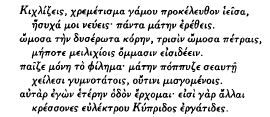No CrossRef data available.
Article contents
The oath at A.P. v. 245.3
Published online by Cambridge University Press: 23 December 2013
Extract
An epigram in the Greek Anthology (A.P. v 245) by Macedonius Consul goes as follows:

The oath here (line 3), τρισὶν ὥμοσα πέτραις, has no precise parallel in antiquity and has, accordingly, puzzled commentators. Emendation was one solution.
- Type
- Notes
- Information
- Copyright
- Copyright © The Society for the Promotion of Hellenic Studies 1978
References
1 Cf. Stadtmüller, H., Anthologia Graeca (Leipzig 1894–1906)Google Scholar, app. crit. ad loc.
2 Cf. Campbell, A. Y., ‘Anth. Pal. V, 244Google Scholar (245). 3–4’ in CR n.s. iii no. 1 (1953) 13.
3 Cf. Jacobs, F., Anthologia Graeca (Leipzig 1794–1814)Google Scholar n. ad loc. (xi 214).
4 Cf. Longman, G. A., ‘Anth. Pal. V, 244 (245). 3’ in CR n.s. v no. 1 (1955) 19Google Scholar.
5 This is fully documented in a forthcoming paper, ‘The Debt of Macedonius Consul to Nonnus’.
6 For instances of Macedonius' borrowing of final words from Nonnus cf. e.g. A.P. v 240.1 with D. iv 301, xxii 262, xl 331, xlii 287; A.P. v 240.3 with D. vi 353, xx 231, xxxi 269, xxxii 26, xxxiii 164, xxxvii 143, xli 408; A.P. vi 40.1 with D. ii 161, iii 104, xii 210, xlvii 329; A.P. vi 56.3 with D. xii 313, 314, 320, 345, 355; A.P. ix 645.7 with D. v 279, xii 37, etc. etc.
7 Cf. Peek, W., Lexicon zu den Dionysiaca des Nonnus (Hildesheim 1968- )Google Scholar, s.v. πέτρα.
8 Quoted by Jacobs, loc. cit.
9 Small stones were used in oaths as follows: (i) at Rome a sharp cutting stone (silex) was used to slay a pig for sacrifice (in conjunction with the oath) and was taken to represent the constancy of the god, while the act of killing symbolised the fate of the perjurer, cf. Liv. i 24. 6–9; 26. 45–8; this oath is related (cf. Dumézil, G., Archaic Roman Religion [Chicago 1970] i 179Google Scholar) to (ii) the ceremony, Jovem lapidem iuvare, in which a man held a stone in his hand and as he threw it from him prayed that he might in like manner be cast out if he broke his oath, cf. Plb. iii 25.8–9; Plu., Sull. 10.4Google Scholar; Paulus, , epit. Fest. 102Google Scholar L s.v. ‘lapidem’; Cic. Fam. vii 12.2; Aul. Gell, i 21.4; Apul. De Deo Soc. 5. A confusion seems to have existed in the minds of the ancients, since the stone was also taken to symbolise the constancy of Jupiter, or (by a different theory) represent his numen (cf. Walbank, F. W., A Historical Commentary on Polybius [Oxford 1957] i 351–3Google Scholar; Dumézil, op. cit. 18–32; 273–4). (iii) Herodotus (iii 8) narrates an Arabic custom of making pledges with seven stones smeared with the blood of both parties. Editors of the Anthology have explained Macedonius’ oath as a variant of either mode (i) or (ii) or a fusion of both: cf. nn. ad loc. in Duebner, F., Epigrammatum Anthologia Palatina (Paris 1864–1890)Google Scholar; Waltz, P., Anthologie Grecque (Paris 1928- )Google Scholar; Beckby, H., Anthologia Graeca (Munich 1966–1967)Google Scholar. Yet both modes are distinctly Roman, appear not to have entered elsewhere into Greek custom, and so are less likely to have been followed by Macedonius. Also the curious Arab ritual (iii) can safely be excluded.
10 Cf. also Demosth. liv 26; Harp. s.v. λίθος; Frazer, J. G., The Golden Bough (Cambridge 1911) i 160 ffGoogle Scholar.
11 Cf. Russell, D. A., Plutarch (London 1972) 146Google Scholar.
12 Cf. Hirzel, R., Der Eid (Leipzig 1902) 212Google Scholar. For superstition in the late Empire cf. Jones, A. H. M., The Later Roman Empire 284–602 (Oxford 1964) ii 957–64Google Scholar.
13 Cf. also the phrase ‘the gospel truth’, used when in fact no oath has been taken.
14 Cf. Sittl, C., Die Gebärden der Griechen und Römer (Leipzig 1890) 140 n. 8Google Scholar; Hirzel, op. cit. 61.
15 For the dative with ὄμνυμι to mean ‘swear by’ cf. Paus., loc. cit.; Aristoph., Nu. 248Google Scholar (v. LSJ s.v. ὄμνυμι).
16 Cf. Hirzel, op. cit. 82–5; Usener, H., ‘Dreiheit’ in RhM lviii (1903) 1–47Google Scholar; 161–208; 321–62 (esp. 17–24); cf. also Lasch, R., Der Eid (Stuttgart 1908) 43Google Scholar; Harrison, E., Essays and Studies Presented to William Ridgeway (Cambridge 1913) 97–8Google Scholar.
17 We have parallels in the English phrases (also separated from the original ritual), ‘I swore on a stack of Bibles’, ‘I swore by all that's holy’; cf. also e.g. Shakespeare, Henry IV, Part I, ii 4.56 ‘I'll be sworn upon all the books (i.e. Bibles) in England’, etc.
18 Cf. Madden, J. A., ‘Macedonius Consul and Christianity’, Mnemosyne xxx (1977) 153–9CrossRefGoogle Scholar.
19 For the custom among poets of the Cycle of writing pagan-seeming epigrams cf. Cameron, A.. Agathias (Oxford 1970) 107Google Scholar.


